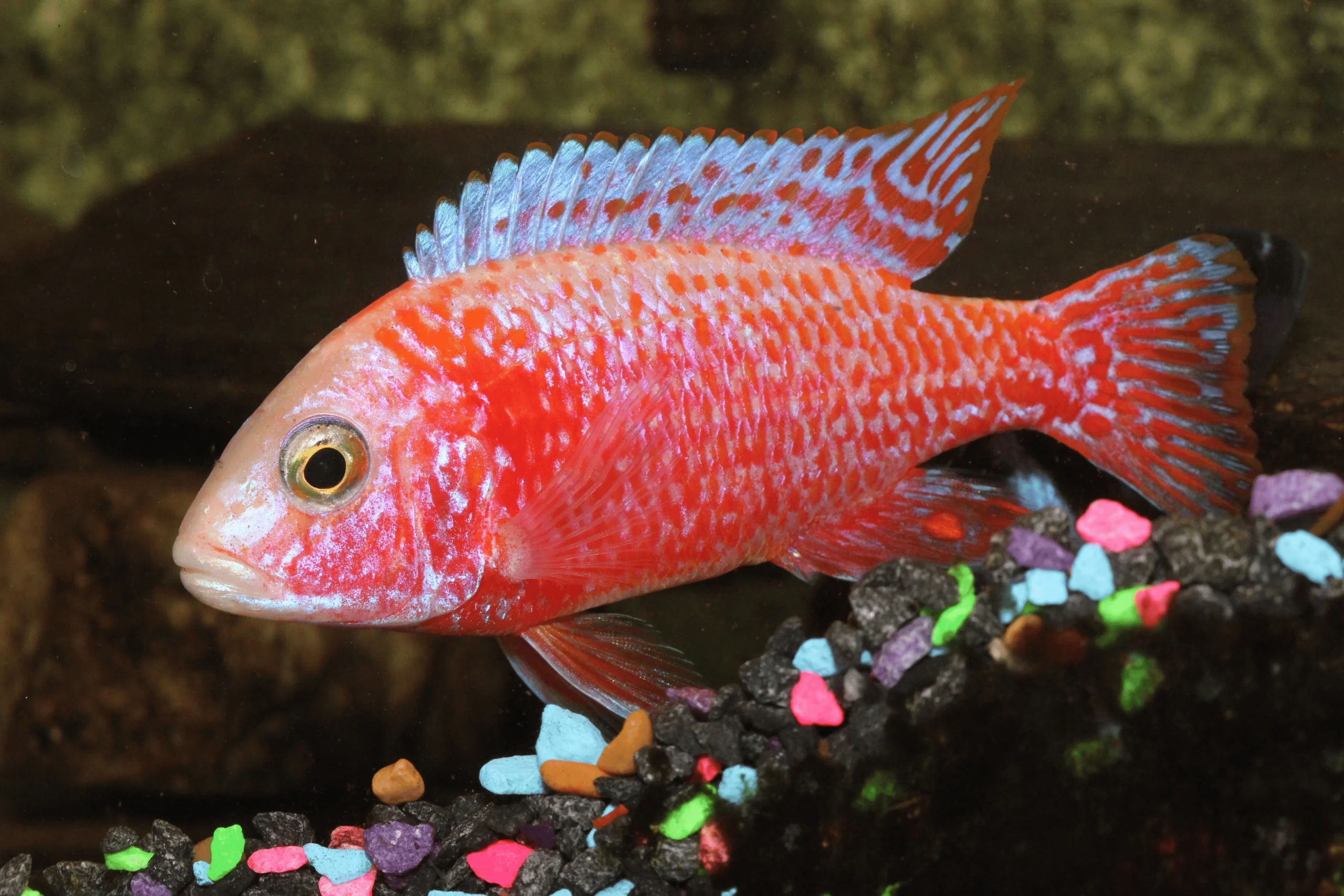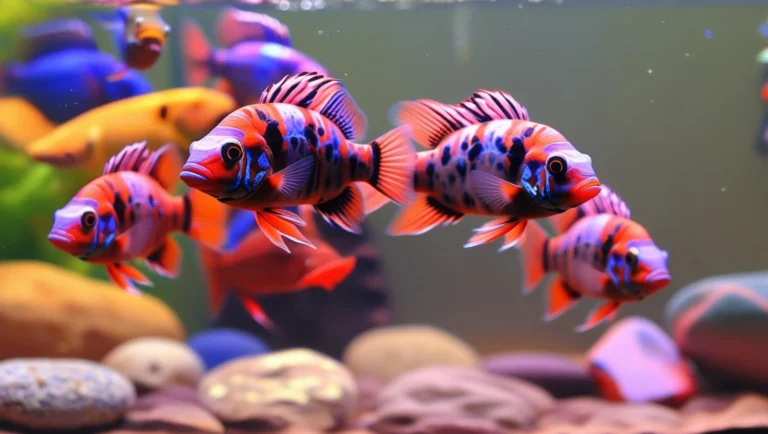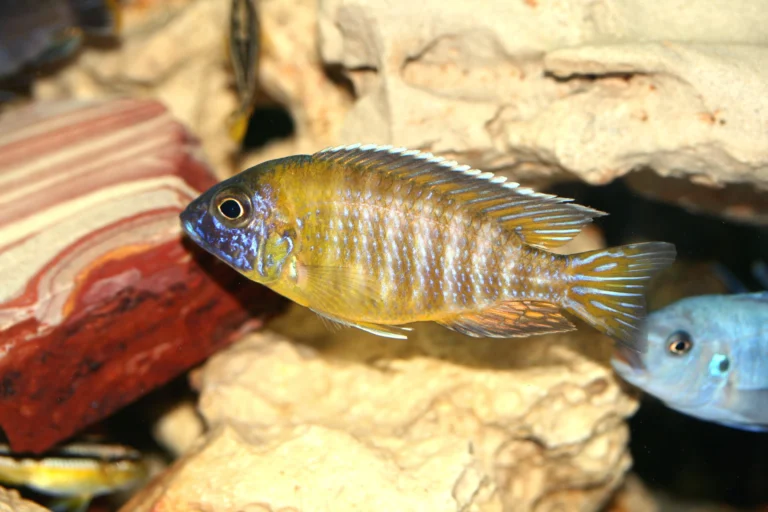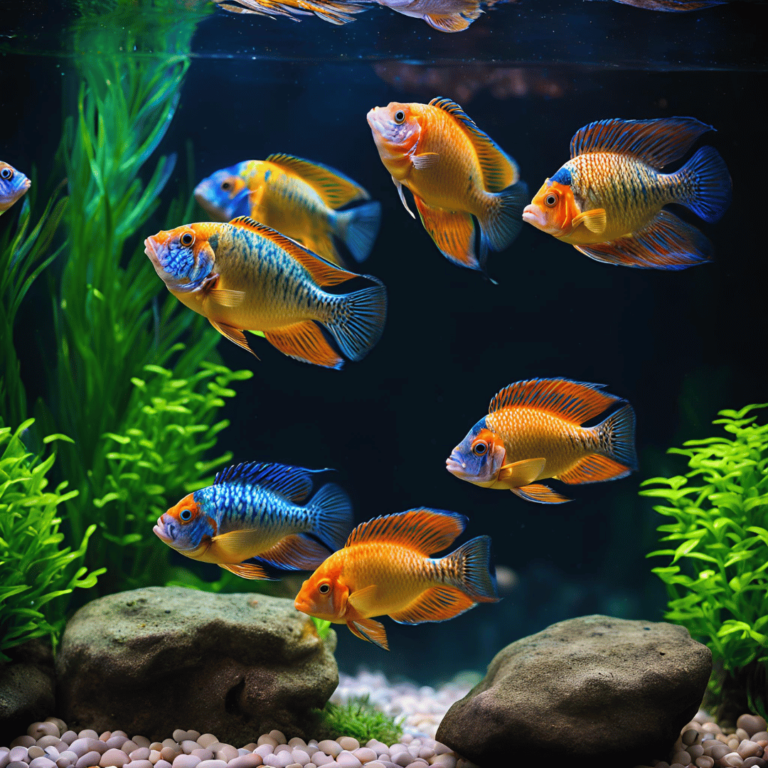Your trusted guide to cichlid care, tank setups, and quality products.

Breeding Peacock Cichlids: 5 Proven Tips for Massive Success
Discover the top 5 breeding triggers for Peacock Cichlids! Learn how to optimize water, tank setup, diet, and lighting to encourage spawning and ensure success.
Image credits Image by Kevin McIver from Pixabay
Peacock cichlids (Aulonocara species) are celebrated for their dazzling colors and fascinating behaviors, making them a favorite among aquarists. Breeding peacock cichlids is both a fulfilling hobby and a chance to witness their captivating reproductive rituals. However, successfully breeding peacock cichlids involves more than simply housing males and females together. Providing the right environment, mimicking their natural Lake Malawi habitat, and meeting specific requirements are essential to encouraging spawning.
In this guide, we delve into five effective breeding triggers for peacock cichlids. By understanding these factors and implementing the recommended practices, you can create an optimal breeding environment for peacock cichlids and enjoy the experience of raising healthy fry.
At PeacockCichlid.com, we believe in transparency and honesty with our readers. Some of the links in this article are affiliate links, which means we may earn a small commission if you make a purchase through them—at no additional cost to you. These commissions help support our site, allowing us to continue providing expert advice, in-depth guides, and valuable content for Peacock Cichlid enthusiasts like you.
We only recommend products that we trust and believe will be beneficial for your aquarium. Thank you for your support!
1. Optimize Water Conditions and Temperature for Breeding Peacock Cichlids
Water quality and temperature are the foundation of successful peacock cichlid breeding. These stunning fish originate from the alkaline, mineral-rich waters of Lake Malawi in East Africa. Recreating these natural water conditions in your tank will significantly increase the chances of breeding peacock cichlids.
Ideal Water Parameters for Breeding Peacock Cichlids
- pH Levels: Maintain a pH range between 7.8 and 8.6 to replicate the naturally alkaline environment of peacock cichlids. Deviations from this range can stress peacock cichlids and reduce spawning likelihood.
- Water Hardness: Keep water hardness between 10 and 20 dGH. This mineral-rich condition supports the health of peacock cichlids and promotes breeding success.
- Temperature: Maintain a consistent temperature of 78°F to 82°F. Slightly raising the temperature by 1–2°F can serve as a natural breeding trigger for peacock cichlids.
Importance of Water Changes
Performing regular water changes mimics the seasonal influx of fresh water in Lake Malawi, which triggers peacock cichlid spawning. Replace 20–30% of the tank water weekly, ensuring the new water matches the tank’s pH and temperature to avoid stressing peacock cichlids.
Enhancing Oxygenation
Peacock cichlids thrive in oxygen-rich water, especially during breeding. Use air stones, sponge filters, or adjust your filter’s outflow to increase surface agitation. Well-oxygenated water supports active breeding behavior in peacock cichlids.
2. Create a Breeding-Friendly Tank Setup for Peacock Cichlids
A proper tank setup plays a pivotal role in encouraging natural breeding behaviors in peacock cichlids. Providing a secure, spacious environment similar to their natural habitat ensures peacock cichlids feel safe enough to spawn.
Optimal Tank Size
For breeding peacock cichlids, a minimum tank size of 55 gallons is essential. This size gives males enough space to establish territories and females room to retreat, reducing stress and aggression. Overcrowded tanks hinder peacock cichlid breeding.
Substrate Selection
Fine sand substrate is the best choice for peacock cichlid breeding. In the wild, male peacock cichlids create nests or “bowls” in sandy areas to attract females. Avoid coarse gravel, as it interferes with nesting and may harm peacock cichlids physically.
Hiding Spots and Flat Surfaces
Rocks, caves, and flat surfaces provide crucial hiding spots for female peacock cichlids and encourage egg-laying. Flat slate rocks or smooth stones are particularly effective as spawning surfaces. This setup reduces stress and promotes natural breeding behavior in peacock cichlids.
3. Maintain the Right Male-to-Female Ratio for Peacock Cichlid Breeding
Balancing the male-to-female ratio in your tank is critical for reducing aggression and ensuring successful peacock cichlid breeding.
Ideal Male-to-Female Ratio
Peacock cichlids are polygamous, meaning one male mates with multiple females. Maintain a ratio of 1 male to 3–4 females to minimize harassment of females by males and allow females to recover between spawnings.
Managing Aggression
Male peacock cichlids are territorial, especially during breeding. To manage aggression:
- Provide plenty of hiding spots and boundaries with rocks and plants.
- Rearrange tank decorations periodically to disrupt established territories.
- Use a tank divider if a male peacock cichlid becomes overly aggressive.
4. Establish a Consistent Lighting Schedule for Breeding Peacock Cichlids
Lighting plays a subtle yet significant role in breeding peacock cichlids. Proper lighting conditions help mimic their natural environment and stimulate spawning.
Simulating Natural Day-Night Cycles
For breeding peacock cichlids, provide 10–12 hours of light daily, followed by a dark period to replicate the natural cycles of Lake Malawi. A consistent lighting schedule, controlled with a timer, reduces stress and encourages peacock cichlids to spawn.
Enhancing Male Coloration
Good lighting enhances the vibrant colors of male peacock cichlids, making them more attractive to females. Use adjustable LED lights to control brightness and showcase the brilliant hues of your peacock cichlids.
5. Provide a High-Quality Diet to Trigger Peacock Cichlid Breeding
Nutrition is crucial for conditioning peacock cichlids to breed successfully. A nutrient-rich diet improves coloration, health, and reproductive success in peacock cichlids.
Foods That Encourage Peacock Cichlid Breeding
- Live Foods: Offer live brine shrimp, daphnia, or bloodworms to replicate the natural diet of peacock cichlids.
- Frozen Foods: High-quality frozen foods like mysis shrimp are excellent alternatives to live food.
- Pellets and Flakes: Use cichlid-specific formulas to provide essential nutrients for peacock cichlids.
Vitamins and Mineral Supplements
Include foods fortified with Vitamin C and Vitamin E for reproductive health. Calcium-rich supplements support eggshell development, enhancing fry survival rates for peacock cichlids.
Feeding Frequency
Feed peacock cichlids 2–3 times daily in small portions. Overfeeding can compromise water quality, which may hinder breeding efforts for peacock cichlids.
Breeding Behavior and Fry Care for Peacock Cichlids
When breeding conditions for peacock cichlids are ideal, male peacock cichlids court females by displaying vibrant colors, creating nests, and performing dance-like movements. Females mouthbrood the eggs for 21–30 days, protecting them until the fry are ready to swim freely.
Tips for Fry Survival
- Transfer mouthbrooding females to a separate tank to reduce stress and aggression.
- Feed fry finely crushed flakes, baby brine shrimp, or specialized fry food.
- Perform regular water changes to maintain pristine water conditions in the fry tank.
Recommended Resources for Breeding Peacock Cichlids
- Water Testing Kits: Monitor and maintain optimal pH and hardness for peacock cichlids.
- Adjustable LED Lights: Showcase male peacock cichlid colors while maintaining consistent lighting.
- High-Quality Cichlid Food: Enhance health and reproductive success in peacock cichlids.
- Fine Sand Substrate: Encourage natural nesting behaviors in peacock cichlids.
- Air Stones and Sponge Filters: Boost oxygenation for active and healthy breeding pairs.
Conclusion: How to Breed Peacock Cichlids Successfully
Breeding peacock cichlids is a rewarding experience for aquarists, but it requires meticulous preparation. Focus on these five key breeding triggers: optimal water conditions, a breeding-friendly tank setup, balanced male-to-female ratios, consistent lighting, and a high-quality diet to create the perfect environment for peacock cichlids.
Take actionable steps today to prepare your tank for peacock cichlid breeding success. With patience and dedication, you’ll soon enjoy the thrill of raising healthy fry and watching your peacock cichlid community thrive.
If you enjoyed these insights on successful breeding, be sure to explore more of our expert advice on peacochcichlid.com. For additional breeding and care strategies, check out our article “10 Proven Tips for Breeding Peacock Cichlids Successfully” as well as “Peacock Cichlid Care: 7 Powerful Tips for Beginners” for a comprehensive guide to overall health and well-being. You can also enhance your aquarium setup by reading “Peacock Cichlid Tank: 10 Expert Tips for a Stunning Setup” and “Peacock Cichlid Tank Setup: 8 Easy Steps for Perfect Results,” which offer practical tips to create the ideal environment for your fish.
We’re continually adding fresh content to help you master every aspect of peacock cichlid care, so don’t forget to visit us again and follow our social media channels for the latest updates and expert insights. Happy breeding and aquarium keeping!
FAQ’s
What are the best water parameters for breeding peacock cichlids?
Maintain a pH of 7.8–8.6, water hardness of 10–20 dGH, and a temperature of 78°F to 82°F. These conditions closely replicate their natural Lake Malawi habitat.
How can I trigger spawning in peacock cichlids?
Trigger spawning by slightly raising the tank temperature by 1–2°F, performing regular water changes, and offering a high-protein diet.
What is the ideal male-to-female ratio for breeding peacock cichlids?
Maintain a ratio of 1 male to 3–4 females to minimize aggression and ensure successful spawning.
What type of substrate is best for peacock cichlid breeding?
Fine sand substrate is ideal, as it allows males to create nests for attracting females.
Do peacock cichlids exhibit parental care?
Yes, female peacock cichlids are mouthbrooders, carrying eggs and fry in their mouths for 21–30 days to protect them.
How can I manage aggression during breeding?
Provide hiding spots, rearrange tank decorations periodically, and use a tank divider if necessary to reduce male aggression.
What should I feed peacock cichlids to encourage breeding?
Offer live foods (brine shrimp, daphnia), frozen foods (mysis shrimp), and cichlid-specific pellets or flakes enriched with vitamins.
How large should the tank be for breeding peacock cichlids?
A tank of at least 55 gallons is recommended to provide sufficient space for territories and reduce stress.
How do I care for peacock cichlid fry?
Transfer the mouthbrooding female to a separate tank, feed the fry crushed flakes or baby brine shrimp, and maintain clean water conditions.
Can I breed peacock cichlids in a community tank?
It’s possible, but a dedicated breeding tank is preferable to minimize stress and aggression and increase fry survival rates.



